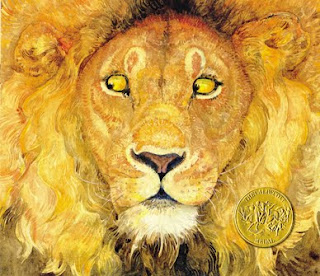
Bryan, Ashley. The Story of Lightning & Thunder. New York: Atheneum Books, 1999.
ISBN: 978-0-689-31836-8
PLOT SUMMARY
The Story of Lightning & Thunder explains to the reader why lightning and thunder now live in the sky with rain instead of living in the village they once occupied. Ma Sheep Thunder and Son Ram Lightning are cast out of their village to the sky because Son Ram Lightning is so uncontrollable and damages parts of the village and market place. Once banished to the sky, Son Ram Lightning tries to strike back to earth when his mother, Ma Sheep Thunder, calls after him!
CRITICAL ANALYSIS
Starting with illustrations, The Story of Lightning & Thunder includes bright, colorful pictures and patterns that allow the reader to really visualize the feelings the Sheep and the Ram are having. The illustrator used thick outlines around the pictures which I love. The way that the illustrator drew the pictures really made the main parts of each page stand out to the reader. Again, the illustrations are stunning with the way to colors and patterns are matched up together to create a harmony of color and words.
Educationally, The Story of Lightning & Thunder offers great opportunities to teach students about morals and folktales. As I read recently in Children’s Literature in Action, students are missing out on the classics. This The Story of Lightning & Thunder is a wonderful example of a recreation of a story passed down from a time before ours. Children have a difficult time wrapping their mind around the fact that stories existed long before they did. This book gives a teacher a great opportunity to teach children a out folktales and to include those classics that students miss out on.
Vardell, Sylvia M. 2008. CHILDREN’S LITERATURE IN ACTION. Libraries Unlimited.
REVIEW EXCERPT(S)
· Publishers Weekly: "Joyful in both word and palette," said PW, "this African story tells why lightning and thunder reside in the sky and not on earth, as they once did."
· The Kirkus Review: “There is one of Bryan's uniquely vibrant, swirling, light-filled paintings on every page.”
CONNECTIONS
· Compare and Contrast: When you have a classic folktale its always fun for students to be able to compare one story to another that is familiar to the folktale.
· Students could work on a research project on other folktales. This would allow for them to not only become more familiar with other folktales but they could also learn more about using databases and researching.




